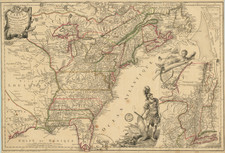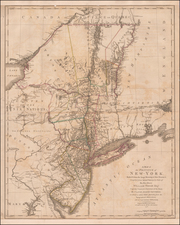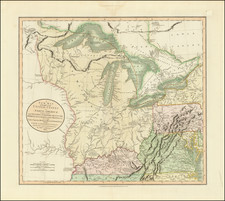Rare plan of the Antietam Cemetery, drawn by Charles P.Kahler, Civil Engineer and lithographed by Hoen & Co. in Baltimore.
The map provides a detailed treatment of the Antietam Cemetery at Sharpsburg, identifying the location of 29 groups of Soldiers, including 4 groups of unknown soldiers. Of speical interest is the location of General Lee's Rock, in the bottom right corner of the map. The rock was the source of controversy from the start and was gone withing 30 years. The following is excerpted from Antietam Cemetery and the Problem of Lee's Rock, by Calvin Fisher, posted on website Crossroads of War:
. . . A.A. Biggs, the man responsible for the design of the cemetery, deliberately diverted the path so as to enclose [General Lee's]rock, indicative of his recognition that there was tangible interest in the rock. Lee's Rock, as the outcropping came to be known, was also included in Antietam National Cemetery as part of a survey later that year meant to portray the Confederate lines during the Battle of Antietam. However, by 1897 the rock was no longer present in depictions of the cemetery.
. . . Lee's Rock gained its name from locals who believed that Confederate General Robert E. Lee had stood upon the boulder to gain a better view of the battlefield during the Battle of Antietam on September 17, 1862. The object was popular to tourists visiting the battlefield, who often stood on the rock as they believed Lee had done. Of more concern to the Board of Trustees of the Antietam National Cemetery were those visitors who broke off pieces to carry away as souvenirs of the battle or, especially troubling to trustees from Northern states, as a relic from the renowned commander. For these board members, the presence of a Southern monument on ground made hallow by the sacrifices of Union soldiers was entirely unacceptable . . .
In March 1866, the New York Times reported that there was a "difference of opinion" among the trustees about the future of Lee's Rock. Two months later, the trustees decreed that the rock should be demolished. . . The rock received a respite from the sledgehammer when the trustees backed away from their decision and instead settled on leaving the boulder intact as a "feature of historic interest."
Rather than view this failed plot to remove the stone as a victory for General Lee's legacy, the Columbus Daily Sun hailed the decision as a "sensible determination," because the board of trustees had refused to martyr Lee's Rock and thereby create a perpetual "moral monument to Lee." . . .
On June 17, 1868 a measure was passed by the Board to remove "all fixed rocks from the cemetery grounds which project above the surface at least one foot." As the only outcropping in the cemetery that met this criterion, Lee's Rock was clearly the intended target of this new ordinance. . . The rock was quietly removed. The Hagerstown Mail claimed that as late as September 1868 few people were even aware of the rock's removal. Instead, the new source of controversy at the cemetery was Maryland's insistence that Confederates killed at the battle be interred at, or adjacent to, the Union soldiers' burial ground.
Seemingly irrelevant to the politicking around Lee's Rock was its veracity as a historical object. Interestingly, Northerners adamant about the need to remove the boulder were more apt to treat the rock as if General Lee had actually stood upon it. Henry Kyd Douglas, a Maryland native who fought for the Confederacy, served
on General Thomas "Stonewall" Jackson's staff and was present at the Battle of Antietam [objected] because it therefore represented "a southern pollution needing to be removed from the landscape." In contrast, Confederate officers who visited the battlefield often rejected the notion that the general did stand upon the outcropping.11 The most prominent repudiation of Lee's Rock's authenticity was issued by Henry Kyd Douglas, a resident of Maryland who served on
Confederate General Thomas "Stonewall" Jackson's staff. According to Douglas, the rock was enclosed by a clump of trees on what would later become Cemetery Hill during the Battle of Antietam. Therefore, he wrote that General Lee never even saw the rock that bore his name, let alone stood on it; even if he had been able to stand upon it, Douglas contended that the only view it would have afforded would have been that of the surrounding trees.On September 17, 1867 the dedication ceremony held at Antietam National Cemetery was attended by "loyal men and women," governors from Northern states, Union generals, and President Andrew Johnson. Conspicuously absent among the soldiers buried there and among the crowd gathered were supporters of the Confederacy. Also soon to be missing was Lee's Rock, an association with the Confederacy deemed unacceptable at a site dedicated to slain Union soldiers.
The map is apparently quite rare (OCLC lists 3 copies-LC, University of Maine and Penn State) and even the Library of Congress copy is in poor condition: memory.loc.gov/cgi-bin/query/h











![[ Extensively Annotated By An Early Owner ] Georgia from the latest Authorities](https://storage.googleapis.com/raremaps/img/small/100877.jpg)

![[Florida Panhandle to Yucatan] Pas-Kaart Van de Golff van Mexico . . .](https://storage.googleapis.com/raremaps/img/small/93130.jpg)
![Carte De La Louisiane Et Du Cours Du Mississipi . . . Juin 1718 [1st State!]](https://storage.googleapis.com/raremaps/img/small/59797.jpg)